As Tourists Flock to Hawaii, One Mayor Asks Airlines for a ‘Pause’

istockphoto.com/MCCAIG
Residents in Maui County have complained about congestion, illegal parking and overcrowding as tourists have resumed travel to the area.
Amid a massive influx of tourists, Maui County Mayor Michael Victorino is pleading with airlines to reduce flights to the island as a cautionary measure as the community continues its recovery from the Covid-19 pandemic.
"I have been talking with different airlines and...asking for just a pause, if you want to use that term," Victorino said at a recent press conference."We don't have the authority to say ‘sStop,’ but we're asking the powers to be to help us."
Tourism has long been Hawaii’s top economic driver, attracting 10.4 million visitors and generating $2.07 billion in state tax revenue in 2019, according to data from the Hawaii Tourism Authority. In 2020, amid pandemic-related travel restrictions, just 2.7 million people visited the islands, a decrease of nearly 74%. Tax revenue from hotel expenditures also plummeted by 89%, to $35.1 million, according to the tourism authority.
As vaccination rates climb nationwide, visitors have begun returning to the islands in droves. In May, 629,681 visitors flew to Hawaii, compared to 9,116 last year. Between July 1 and July 7, 234,641 people arrived there by plane, compared to 22,562 for the entire month of July last year.
“Covid-19 stopped everyone from going almost everywhere, so now Maui, and the state of Hawaii, have become a focus point for that pent-up demand,” Victorino said. “If you imagine how much of the rest of the world is closed right now...people are choosing to come to Hawaii not only because of it’s wonderful resources and people, but because there really is not a lot of choices.”
The surge is a mixed blessing, Victorino said. The tourism revenue is welcome, but many of the island’s hospitality businesses—including restaurants, hotels and rental car companies—remain understaffed, leaving the community scrambling to accommodate the increased numbers of visitors. Since spring, illegal parking and traffic congestion have increased, prompting the county to work with state legislators to install signs and implement fees for violations on popular roadways.
“I understand the anger and frustration of our residents, especially those who live in the Hana region,” Victorino said in a statement announcing those measures. “I don’t believe these visitors would stop in the middle of the road or park illegally in their own hometowns and endanger the safety of others, so why are they doing it here?”
The uptick in visitors has also led to congestion at airports, including the Kahului Airport, Maui’s main hub. Travelers are “bottlenecked” at both arrival and departure, Victorino said, leading to crowding that defies social distancing guidelines at a time when dangerous variants of the coronavirus are on the rise.
“It’s become a real challenge,” he said.
Because the county has no authority over airline planning, it’s unclear whether the mayor’s plea will be effective. Because of that, county officials have explored longer-term solutions as well, including a two-year moratorium on building permits for new hotels in certain parts of Maui. The measure, approved 6-2 by the Maui County Council, aims to promote environmental sustainability while also giving officials a chance to reexamine its approach to tourism.
“The council believes interim restrictions on new visitor accommodations would allow the county time to implement critical plan action items relating to visitor industry impact on the county's environment and provide the county with clear policy direction for day-to-day decision-making to mitigate climate change and work toward resilience,” the proposal says.
Councilmember Kelly Takaya King, the measure’s lead proponent, was more blunt.
“While the county doesn’t have the authority to stop airlines from bringing more visitors,” she said at the council’s July 2 meeting, “it does have authority over building permits and accommodations development.”
Kate Elizabeth Queram is a senior reporter for Route Fifty and is based in Washington, D.C.
NEXT STORY: DOJ to Help Rural and Tribal Law Enforcement Agencies Buy Body-Worn Cameras





